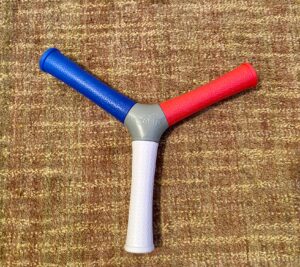Brian Schiff’s Blog
Injury Prevention, Sports Rehab & Performance Training Expert
Over the years, I have tested many different fitness products through my work with Personal Fitness Professional Magazine. I am not paid to promote any products on my site, and this latest review comes after spending the past few weeks using this particular product in the clinic with my patients. I am pleased to bring attention to it because I think it can help with recovery and training.
Recently, the inventor of the HECOstix, Josh Broeker, reached out to me to see if I have had a chance to use his product. Much to my surprise, I was not familiar with it. As a performance physical therapist working with many athletes from various sports and ranging from youth to professionals, I was naturally excited to see the product in action. I am always looking for ways to enhance neurocognitive training and my rehab. Josh was gracious enough to send me a few HECOstix to try out.
For those unfamiliar with the product, see the image of the Red, White and Blue version below:

As I rehab and progress athletes back to sport after injury, implementing tools to improve hand eye coordination, reaction time, cognitive skills and decision making is important prior to sending them back to practice and sport. A few of the really cool features I like about this product include:
- Lightweight and durable EVA make-up
- Different versions and multiple colors allow for auditory cues and quick reaction
- It can be used safely by all ages and abilities
- Travels easily with you anywhere
The HECOstix can be used for virtually any sport and done indoors or outdoors. Perhaps the greatest thing about the product is that it injects FUN into training while allowing users to compete against others or their own results in an effort to improve performance. This tool also allows for progressive challenges moving from underhand to sideways to overhead throws depending on the functional demands and skill level of the participants.
In the clinic, I have been using it with some of my patients rehabbing after ACL reconstruction. Adding neurocognitive training is essential for full recovery and secondary prevention. below is an article from Sports health discussing neurocognitive and neurophysiological functions related to ACL injury:
https://pubmed.ncbi.nlm.nih.gov/34236003/
Specifically, I have integrated it with dynamic balance and movement drills calling out a color while throwing the HECOstix toward the client. I have also had a pair of patients throwing and calling out the color as part of a rehab game. I will be continuing to use it with this population and other athletes working on hand eye coordination and cognitive training for their sport.
If you are looking to add a new wrinkle to your training or rehab, I highly recommend giving this product a try. For more information on the product, be sure to visit www.hecostix.com.
Tightness in the hip flexors is very common. If you have a job that requires extensive sitting or spend lots of time cycling, this may be a problem area for you. Stiffness can limit gait mechanics and optimal movement patterns thereby putting undue strain on the lower back. Below is a simple corrective exercise that can be done routinely to help improve flexibility using a sliding disc.
As 2020 draws to a close and no holiday travel due to COVID, I found myself spending extra time scanning Twitter, IG and some various blogs related to training and rehab last week. I remember starting my blog many years ago prior to the birth of Twitter and IG (I am feeling old typing that lol). My purpose with this blog has always been to freely share information with clients, the general public and practitioners.
Now, more than ever, there is a plethora of opinions, videos, posts and methods on multiple platforms out there on the web. Many people seek clicks, followers, validation, attention, ad revenue or internet fame. It becomes easy to quickly go down a rabbit hole and become consumed with back and forth convos, online debates about the best exercise techniques/methodology, sales pitches for training programs, and in general what I deem to be excessive or over the top ‘look at me’ promotional posts by certain people. On one hand, the internet is a gift that gives us all a bigger platform and voice, including me. On the other hand, it can also muddy the water, create division among the ranks, and propagate consumer confusion as to what is best for him/her in rehab and training circles.
The spirit and purpose of this year-end blog post is one of a cautionary tale for consumers and young professionals. As someone more seasoned with 24 years of experience rehabbing and training clients, I feel it is important to step back and remember a few important things in this era of instant gratification and access to countless online videos, programs and opinions just a few clicks away.
One of the biggest issues I see today in youth sports is an abundance of overuse and preventable musculoskeletal injuries due to improper conditioning, lack of recovery or both. In the current era of sports specialization and the hyper-competitive pursuit of college scholarships, an athlete can unknowingly be placed in a comprising position with respect to his/her physical and mental health. Coaches and parents may push a player to participate in a weakened or vulnerable state.
Now, more than ever, athletes who do focus in on a singular sport need a year-round training plan to match their year-round sport demands. In order to stave off injury and avoid burnout, a successful plan must accomplish the following:
- Implement de-loading periods along with scheduled rest in the training and competitive cycles
- Periodize the training to peak at the desired times
- Allow for adequate time to ramp up training and sport specific activity in order to condition the body for the high demands of the sport and safely move from the athlete’s “floor” to the “ceiling”
A surefire recipe for injury and soft tissue failure is progressing training loads too fast, where the athlete often endures too much acute workload without enough time to build up an adequate amount of loading tolerance or chronic workload. I see this frequently in baseball pitchers (shoulder and elbow pain), female soccer and basketball players (patellofemoral pain), along with many athletes who suffer soft tissue strains including hamstring, hip flexor and groin injuries.
Tim Gabbett, published an excellent clinical commentary in the October edition of JOSPT (1) that highlights the importance progressing training loads to minimize injury risk and optimize performance. Specifically, he discusses the concepts of “floor”, “ceiling” and “time” as it relates to developing rehab and performance plans.
Floor – the athlete’s current level of capacity
Ceiling – the capacity needed to perform the specific acuities of their sport
Time – an athlete can safely progress from the floor to the ceiling when afforded enough time
Further, Tim discusses how an injured athlete can actually fall behind in conditioning and end up in the “basement” in terms of training capacity. This presents additional challenges in getting the injured athlete back safely, particularly if it is in-seasonwith a shorter time window. He presents an option of raising the floor when an athlete enters rehab or if he/she will be on an extended break from training to ensure the loading capacity not drop below the floor to the basement, but rather increase the height of the floor, perhaps allowing the athlete to eventually reach a higher ceiling (greater loading capacity) later on.
According to Gabbett, there are 5 key ways to ensure athletes are prepared for competition:
- Maintain adequate training load during the offseason and while injured.
- Identify the ceiling and make sure the training load is in line with the sport’s demands.
- Assess individual differences in training tolerance. We need to consider young versus older athletes, injuries, training history, aerobic fitness and physical deficiencies to do this properly.
- Identify and prepare for the most demanding parts of competition.
- Coaches need to plan enough time to move from the floor to the ceiling considering the physical demands of the sport, capacity needed to perform these activities, and individual limiting factors that may impede the ability to meet these demands.
Having spent a considerable amount of my career working with high level amateur and professional athletes, I am well aware of the narrow windows of time to compete and recover with weekend tournaments and professional schedules. It takes a lot more time to get in elite shape and only a few days to begin detraining. Cross training, smart and progressive rehab and clear communication with coaches, training staff and the athlete is essential in managing an injury for a high level athlete.
In addition, I always tell my athletes the only thing worse than not competing at all is going out and performing poorly. Without proper training and rehab plans, athletes will eventually fail mechanically. I often encourage the athlete to communicate clearly in terms of pain response on a scale of 1-10 during, immediately after and for the 24 hour period following rehab to assess the body’s response to loading. Using these concepts and the floor, ceiling and time as discussed by Tim Gabbett, strength coaches, sport coaches and rehab professionals can all refine their methods to put the athlete in the best position to succeed and reduce injury risk.
References:
- Gabbett TJ. How much? How fast? How soon? Three simple concepts for progressing training loads to minimize injury risk and enhance performance. J Orthop Sports Phys Ther. 2020 Oct;50(10):570-573.
I am currently working to attain my transitional doctorate in physical therapy (tDPT) at Northeastern University. As I continue to work full time as a clinician, it has been really cool to apply the learning with my current caseload. At this time, I am in a motor control class that is both fascinating and challenging. In week three, we examined pain and the impact it has on neuroplasticity (the brain’s ability to adapt or change).

In the sports medicine realm, I generally think many practitioners solely focus on the musculoskeletal system or physical impairment. As such, interventions are developed around tissue constraints, ROM deficits, weakness, etc. Too often, we look past the power and impact of the brain and how it plays a vital role in healing and return to play. For some patients, there is a maladaptive response to injury/surgery and a hypersensitivity of the central nervous system or central sensitization that occurs. Pelletier (2015) notes that structural and functional changes can occur. (1)
Two critical concepts to consider here are:
- Sensory amplification – sensory and motor representations change resulting in perceptual changes in body image, motor control changes, and even a persistence or amplification of pain
- Experience dependent plasticity – patient’s response to pain is related to prior experience and may experience maladatpive imprinting where the pain outlasts the physical insult
Kleim (2008) gives a great lesson on experience dependent plasticity and states that learning is essential for the brain to adapt to damage self taught behavioral changes can be maladaptive or positive and specific forms of neural plasticity and associated behavioral changes are dependent on specific kinds of experience (2). While one would assume that chronic pain is rare in athletes, I would counter and say it is probably just overlooked as we tend to expect athletes to “push through the pain” because of the driven culture we live in. Coaches, parents and even teammates can affect the mindset around injury and recovery.

